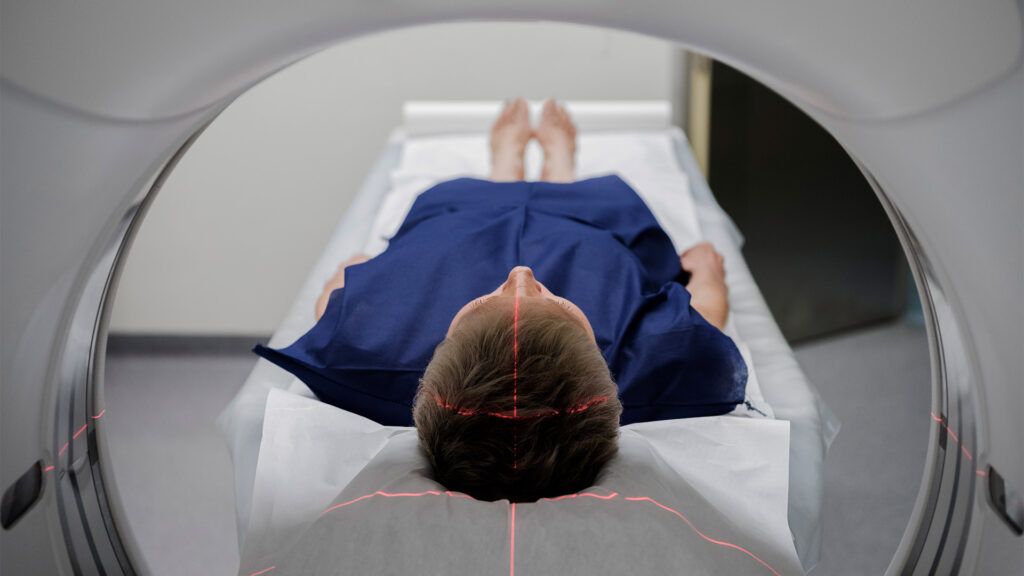Radiologically isolated syndrome (RIS) is when a person has lesions in the brain or spinal cord that are consistent with diseases such as multiple sclerosis (MS), but they have no neurological symptoms.
These lesions in the brain can indicate that a person has a demyelinating disease. These are conditions that damage the protective sheath around nerves, including MS.
However, having RIS does not necessarily mean a person will develop one of these conditions. It
Keep reading to learn more about RIS, including the signs, causes, treatment, and outlook.

Radiologically isolated syndrome (RIS) is the medical term for when a person has lesions consistent with MS on an MRI scan but no previous neurological symptoms.
The lesions are present in the white matter of the brain or on the spinal cord. They appear similar to the lesions of a demyelinating disease.
Today, radiologists report these lesions more frequently because people are having more MRI scans. For example, doctors may order MRIs for people with headaches, head trauma, or dizziness. In the process, they can unexpectedly find lesions in people who do not have symptoms consistent with MS.
However, only some of the people with RIS will go on to develop a neurological condition. It is unclear how common RIS is, but a 2020 review says that incidental findings show RIS in between
Clinically isolated syndrome (CIS) is similar to RIS but includes at least one episode of neurological symptoms that suggest a demyelinating disease.
Compared with RIS, CIS occurs in many people with early signs of MS. It can be the first sign a person has the condition.
However, not everyone with CIS gets MS. According to previous research, around
Approximately 31–44% of people with CIS will have new neurological attacks within 3 years after their initial symptoms, though. This is known as clinically definite MS (CDMS).
People with CIS may also have follow-up MRIs showing new lesions but never experience a second neurological attack. Doctors call this radiologically definite MS (RDMS).
People with RIS, by definition, do not have any symptoms. The lack of symptoms is part of the criteria for the condition.
If a person does have any neurological symptoms, they may have another condition.
Lesions in the brain can develop for
- infections
- concussion
- certain drugs
- vascular conditions
However, when there are no other explanations for the lesions, they can be RIS. Doctors do not know why RIS occurs nor why MS occurs in some people and not others.
Radiologists may find lesions on the brain or spinal cord when investigating other symptoms via an MRI. If they identify lesions that fulfill certain criteria, it could be RIS.
However, RIS is a diagnosis of exclusion. This means that doctors diagnose RIS through a process of eliminating other potential causes for the findings. This may involve undergoing a range of tests and examinations before they can come to a firm conclusion.
They may take a detailed medical history, asking about:
- any other symptoms
- a personal or family history of blood vessel conditions or neurological conditions
- current medications
- substance misuse
Blood tests may rule out other conditions that can mimic MS, such as:
- nutritional deficiencies
- infections
- rheumatic diseases
If no cause for the lesions becomes apparent, a doctor may ask for a physical examination. The aim of this is to attempt to discover any subtle neurological symptoms a person may not notice. If there are no neurological symptoms, the person may have RIS.
Doctors may also order further tests to look for biomarkers of MS, such as a lumbar puncture or blood tests to search for any signs of autoimmunity or inflammation.
Once a doctor confirms that a person has RIS, there are several approaches they can take.
Monitoring
A doctor may suggest monitoring the lesions with further MRI scans to determine if they are growing or changing.
At these follow-up appointments, the doctor may ask questions to see if a person has any neurological symptoms, and they may perform physical tests to rule this out.
However, there are
Risk reduction
In some people with RIS, doctors may recommend making dietary or lifestyle changes that could reduce their risk of developing MS. This
They may also recommend stopping smoking, if relevant. Smoking has links to a higher risk of MS and a more aggressive disease course for those who do develop the condition.
MS treatment
Some doctors may consider starting people with RIS on MS treatment if they are at high risk of conversion to MS. This
- are younger in age
- have a family history of MS
- have lesions in the cervical or thoracic spinal cord
- have biomarkers for MS in their blood or spinal fluid
However, MS treatments have significant risks, and there is a chance people could undergo treatment unnecessarily.
As a result, many doctors will avoid treating RIS unless the risk is high, a person develops symptoms, or they find new biomarkers suggesting a person has inflammation in follow-up appointments.
The outlook for those with RIS is
According to a
At present, there is no data on the life expectancy of people with RIS versus the rest of the population. The outlook for those with MS depends on which type of MS a person gets, along with other factors.
MS is not a curable disease, but some treatments can help slow its progression and reduce the number of attacks. There are also medications and therapies to help people manage the symptoms, such as physical therapy to aid in balance and walking.
Learn more about life expectancy for people with MS.
People with radiologically isolated syndrome (RIS) have white matter lesions in their brain or spinal cord that resemble MS lesions, but they have no history of neurological symptoms. Doctors may find these lesions via an MRI scan for other conditions.
Many people with RIS never develop MS. However, they can be at a
